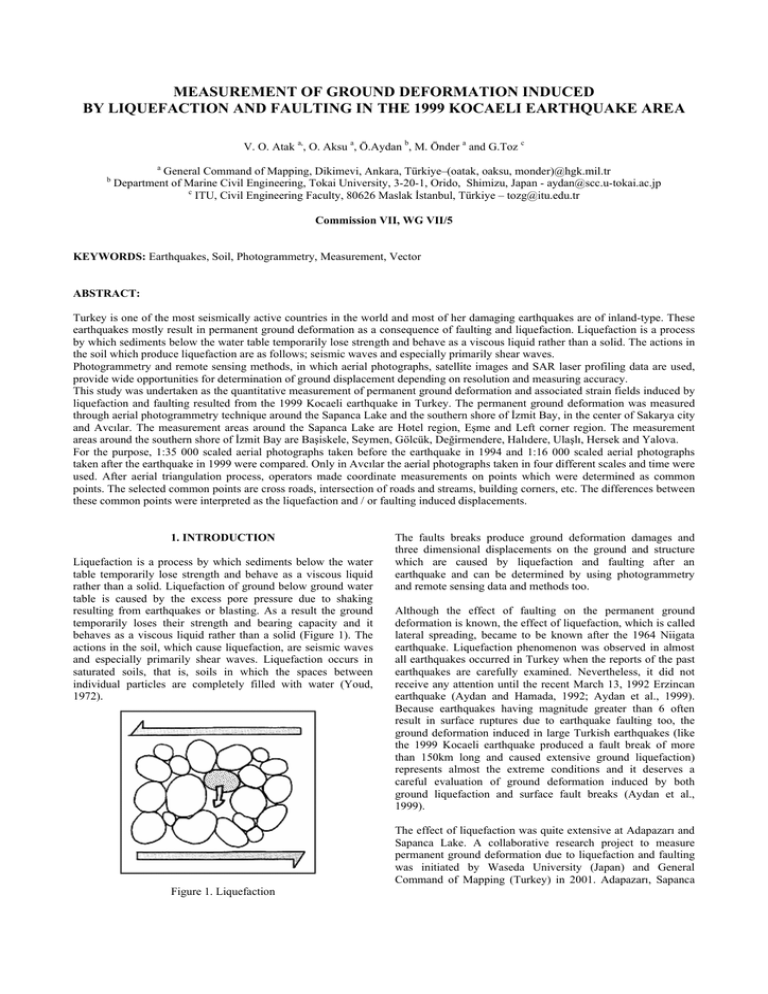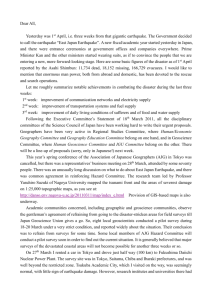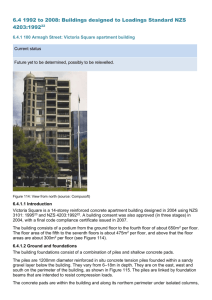MEASUREMENT OF GROUND DEFORMATION INDUCED
advertisement

MEASUREMENT OF GROUND DEFORMATION INDUCED BY LIQUEFACTION AND FAULTING IN THE 1999 KOCAELI EARTHQUAKE AREA V. O. Atak a,, O. Aksu a, Ö.Aydan b, M. Önder a and G.Toz c b a General Command of Mapping, Dikimevi, Ankara, Türkiye–(oatak, oaksu, monder)@hgk.mil.tr Department of Marine Civil Engineering, Tokai University, 3-20-1, Orido, Shimizu, Japan - aydan@scc.u-tokai.ac.jp c ITU, Civil Engineering Faculty, 80626 Maslak İstanbul, Türkiye – tozg@itu.edu.tr Commission VII, WG VII/5 KEYWORDS: Earthquakes, Soil, Photogrammetry, Measurement, Vector ABSTRACT: Turkey is one of the most seismically active countries in the world and most of her damaging earthquakes are of inland-type. These earthquakes mostly result in permanent ground deformation as a consequence of faulting and liquefaction. Liquefaction is a process by which sediments below the water table temporarily lose strength and behave as a viscous liquid rather than a solid. The actions in the soil which produce liquefaction are as follows; seismic waves and especially primarily shear waves. Photogrammetry and remote sensing methods, in which aerial photographs, satellite images and SAR laser profiling data are used, provide wide opportunities for determination of ground displacement depending on resolution and measuring accuracy. This study was undertaken as the quantitative measurement of permanent ground deformation and associated strain fields induced by liquefaction and faulting resulted from the 1999 Kocaeli earthquake in Turkey. The permanent ground deformation was measured through aerial photogrammetry technique around the Sapanca Lake and the southern shore of İzmit Bay, in the center of Sakarya city and Avcılar. The measurement areas around the Sapanca Lake are Hotel region, Eşme and Left corner region. The measurement areas around the southern shore of İzmit Bay are Başiskele, Seymen, Gölcük, Değirmendere, Halıdere, Ulaşlı, Hersek and Yalova. For the purpose, 1:35 000 scaled aerial photographs taken before the earthquake in 1994 and 1:16 000 scaled aerial photographs taken after the earthquake in 1999 were compared. Only in Avcılar the aerial photographs taken in four different scales and time were used. After aerial triangulation process, operators made coordinate measurements on points which were determined as common points. The selected common points are cross roads, intersection of roads and streams, building corners, etc. The differences between these common points were interpreted as the liquefaction and / or faulting induced displacements. 1. INTRODUCTION Liquefaction is a process by which sediments below the water table temporarily lose strength and behave as a viscous liquid rather than a solid. Liquefaction of ground below ground water table is caused by the excess pore pressure due to shaking resulting from earthquakes or blasting. As a result the ground temporarily loses their strength and bearing capacity and it behaves as a viscous liquid rather than a solid (Figure 1). The actions in the soil, which cause liquefaction, are seismic waves and especially primarily shear waves. Liquefaction occurs in saturated soils, that is, soils in which the spaces between individual particles are completely filled with water (Youd, 1972). The faults breaks produce ground deformation damages and three dimensional displacements on the ground and structure which are caused by liquefaction and faulting after an earthquake and can be determined by using photogrammetry and remote sensing data and methods too. Although the effect of faulting on the permanent ground deformation is known, the effect of liquefaction, which is called lateral spreading, became to be known after the 1964 Niigata earthquake. Liquefaction phenomenon was observed in almost all earthquakes occurred in Turkey when the reports of the past earthquakes are carefully examined. Nevertheless, it did not receive any attention until the recent March 13, 1992 Erzincan earthquake (Aydan and Hamada, 1992; Aydan et al., 1999). Because earthquakes having magnitude greater than 6 often result in surface ruptures due to earthquake faulting too, the ground deformation induced in large Turkish earthquakes (like the 1999 Kocaeli earthquake produced a fault break of more than 150km long and caused extensive ground liquefaction) represents almost the extreme conditions and it deserves a careful evaluation of ground deformation induced by both ground liquefaction and surface fault breaks (Aydan et al., 1999). The effect of liquefaction was quite extensive at Adapazarı and Sapanca Lake. A collaborative research project to measure permanent ground deformation due to liquefaction and faulting was initiated by Waseda University (Japan) and General Command of Mapping (Turkey) in 2001. Adapazarı, Sapanca Figure 1. Liquefaction Lake vicinity and south coast of İzmit Bay are the areas of interest in the project. The permanent ground deformations were measured through the aerial photogrammetry technique at several sites within the earthquake region. The three-dimensional coordinates of the common points on pre- and post- earthquake photographs were determined, and the differences between them are interpreted as the liquefaction and faulting induced displacements (Aksu et al., 2002). Vectors obtained form Eşme measurements show a displacement implies especially with faulting in the east and southeast direction. Obtained vectors from the west corner of Sapanca Lake do not show a unique direction. There is a similar movement with that of Eşme in the north of the model, while sparse movement in the south of model because of varying soil structure and locating fault. And vectors in the area of Sapanca Otel have directions mainly to north, upward the Lake because of the liquefaction (Figure 2). To explain the results better, detailed measurements have been made at coastline area of first measurement regions too. 2. MEASUREMENTS Geodetic surveying activities were carried out and aerial photographs were taken in 1:16.000 scales covering the areas Avcılar, Yalova, İzmit, Adapazarı by General Command of Mapping on September 8th, 1999 after the Marmara earthquake. It is ideal to use aerial photographs pertaining to pre- and postsituation of earthquake in large scales (such as 1:5.000, 1:10.000) for determination of liquefaction and faulting. But because of not having triangulation points of 1:16.000 scaled photos taken in 1970, 1:35.000 scaled aerial photographs taken in 1994 were to be used instead. Although it seems a disadvantage to use small scale photographs, temporal resolution that is closest dates for the pre- and post-situation aerial photographs is especially preferred in the areas like Marmara region which have dense new structuring. Digital aerial triangulation measurements and block adjustments were implemented using scanned aerial photographs in 21 µ m. Root mean square error of 6-8 µ m. obtained from this process is normally acceptable for topographic mapping in GCM. As many and well-distributed common points as possible have been selected on the aerial photographs for coordinate measurements. These points are on the features where artificial displacements are minimum, such as junction of roads, bridges and buildings (Atak et al., 2003). After obtaining the horizontal and vertical displacements, images and displacement vectors were merged and so the results could be interpreted (Hamada, 1992). First, cartesian coordinates have been measured in the photogrammetric models of Sapanca Lake vicinity. Movement vectors have been calculated by means of coordinate differences of the common points. Results about the Sapanca Lake measurements can be seen in Table I. SAPANCA LAKE AREA NAME Point Number RESULTANT VECTOR <(POST-PRE)(1999-1994)> DE DN DL DV (m) (m) (m) (m) OTEL Mean_1 418 0.410 0.835 Mean_2 219 0.467 1.207 EŞME Mean_1 305 2.351 -0.428 Mean_2 122 2.575 0.193 LEFT SIDE Mean_1 423 0.608 0.291 Mean_2 50 1.304 0.764 Mean_2=Detailed Measurements 1.460 1.778 -1.714 -2.041 2.660 2.849 0.617 0.762 3.036 2.245 0.602 0.131 Table 1. Sapanca Lake area measurements and results Figure 2. Displacement vectors around the Sapanca Hotel Second phase measurements were also implemented in eight different areas on the coastline of İzmit Bay in addition to Sapanca Lake. Obtained results can be seen in Table II. İZMİT BAY AREA NAME Point Number BAŞİSKELE Mean 48 SEGMEN Mean 117 GÖLCÜK Mean 92 DEĞİRMENDERE Mean 132 HALIDERE Mean 66 ULAŞLI Mean 71 HERSEK Mean 145 YALOVA Mean 301 RESULTANT VECTOR <(POST-PRE)(1999-1994)> DE DN DL DV (m) (m) (m) (m) -1.389 -1.482 2.766 1.021 -1.064 -1.146 2.317 -0.132 -1.580 -1.259 2.440 -2.481 -1.354 -1.215 2.445 -0.602 -1.278 0.385 2.058 -1.454 -0.438 -0.354 1.399 -0.680 -2.069 -1.112 2.881 -1.505 1.637 0.709 2.155 1.037 Table 2. İzmit Bay measurements and results Displacement vectors obtained form İzmit Bay measurements show a displacement implies mostly with faulting, but implies especially at coastline area with liquefaction too (Figure 3). Figure 4. Displacements around Sakarya Figure 3. Displacement vectors at Seymen Third phase measurements were also implemented in the Sakarya city center and at 12 different sites where US and Turkish investigators conducted detailed ground surveys and geo-technical investigations. Displacement vectors obtained form Sakarya city center are shown in Table III. SAKARYA CITY CENTER AREA Point NAME Number But at the same time, the effect of liquefaction can be seen in the changes of vertical coordinates. The detailed results are still being interpreted (Figure 5). RESULTANT VECTOR <(POST-PRE)(1999-1994)> DE DN DL DV (m) (m) (m) (m) CITY CENTER AND 12 SITES Mean 616 1.255 -0.775 SITE A Mean SITE B Mean SITE C Mean SITE D Mean SITE E,K,L Mean SITE F Mean SITE G, J Mean SITE I Mean SITE H Mean Displacement vectors obtained from Sakarya measurements show ground deformation associated with faulting in the east and southeast direction (Figure 4). 1.715 -1.625 23 1.430 -0.850 1.779 -2.391 31 1.207 -1.216 1.749 -2.369 26 1.277 -0.857 1.709 -2.561 23 1.108 -0.567 1.471 -0.720 31 0.904 -0.766 1.668 -1.437 23 1.570 0.201 1.718 -1.023 37 1.824 -0.294 1.913 -0.693 16 1.385 -0.866 1.700 -2.367 40 0.849 -0.538 1.129 -0.515 Table 3. Sakarya City measurements and results Figure 5. Measurement sites in Sakarya And the last measurements were also implemented in Avcılar. In these measurements, aerial photographs taken in four different scales and time were used. These photographs were taken in 1987 and in 1:18 000 scale, in 1993 and in 1:35 000 scale, in 1998 and in 1:18 000 scale and after earthquake in 1999 and in 1:16 000 scale (Figure 6). These results show us that the movements have different characteristics in these measurements. The displacements between the years 1998 - 1993 have a reverse direction when they compared with the displacements between the years 1993-1987. And of course the displacements between the years 1999 and 1998 have also another characteristic because of the earthquake. But it is interesting that the displacements between the years 1993 and 1987 have same directions with the displacements occurred in the earthquake in horizontal coordinates (Figure 7 and 8). Figure 6. Aerial Photograph of Avcılar Applying measurements on the different scaled and dated aerial photographs, the aim was to explain the movements occurred not only with earthquake but also before earthquake too. Figure 7. Displacement vectors for horizontal coordinates between the years 1999 and 1987 Displacement vectors that obtained from Avcılar measurements were presented for the years 1993 - 1987, 1998 – 1987, 1998 – 1993, 1999 – 1987, 1999 – 1993 and 1999 - 1998. The results of these vectors are shown in Table IV. AVCILAR AREA RESULTANT VECTORS DE (m) DN (m) DL (m) DV (m) Between 1993 and 1987 -0.293 0.693 1.157 1.183 Between 1998 and 1987 0.179 0.331 0.621 -0.595 Between 1998 and 1993 0.471 -0.380 0.914 -1.782 Number of Points = 190 Between 1999 and 1987 -0.024 0.755 0.944 -1.093 Between 1999 and 1993 0.269 0.062 0.749 -2.257 Between 1999 and 1998 -0 204 0.424 0.633 -0.514 Table 4. Avcılar measurements and results Figure 8. Displacement vectors for vertical coordinates between the years 1999 and 1987 3. CONCLUSION REFERENCES The 17 August 1999 earthquake has revealed that reliable and rapid information about the effects and affected areas is one of the vital issues. Photogrammetry and remote sensing methods and means provide rapid and reliable information sources. On the other hand, scientific activities on earthquake research can be classified based on geodesy-geology, photogrammetryremote sensing and geographic information systems. Of these, geodesy and geology deals with plate motion and soil mechanics. And GIS based methods provide information for rescue, determination of damaged structures and rebuilding. Aksu, O., Bardet, J.P., Atak, V.O., Önder, M., Aydan, Ö., 16-18 December 2002, Measurement of Ground Deformation Induced by Liquefaction and Faulting in the Earthquake Area of the 1999 Kocaeli Earthquake, The Eight U.S.-Japan Workshop on Earthquake Resistant Design of Lifeline Facilities and Countermeasures against Liquefaction, Tokyo, Japan. Photogrammetry and remote sensing based methods, in that aerial photographs, satellite images and SAR laser profiling data are used, provide wide opportunities for determination of ground displacement depending on resolution and measuring accuracy. Aerial photographs can be used especially both in detailed analysis studies of the limited comprehensive earthquake affected areas and as a reliable data source for the reconstruction applications by means of orthophoto maps produced in the wide comprehensive affected areas. The main components, which affect reliability and accuracy, are; - The images have to be taken in a limited time range and in the same part of the year, - Aerial photographs pertaining to pre- and post-situation of earthquake have to be in large scales (such as 1:5.000, 1:10.000). Based on the aerial photogrammetric evaluations conducted along the southern coast of the Sapanca Lake, displacement vectors determined show a liquefaction movement and confirm the site observations, which were done at liquefaction areas. It is also noted that towards the south part of Sapanca town, where liquefaction has not been observed, some displacement vectors were also determined. These vectors indicate some displacement contributing to the main deformations due to liquefaction induced lateral spreading along the coast of the lake. On the contrary to these, displacement vectors at the northern part of Sapanca Lake - Esme, at the northern part of left corner of Sapanca Lake are parallel to the fault, which caused the earthquake. At this part of the site no liquefaction has occurred, and therefore, it can be concluded that the permanent ground deformation is highly associated with the movement of the fault. Photogrammetric evaluations conducted along the southern coast of the İzmit Bay and in the Sakarya city center, displacement vectors determined show a movement of liquefaction and faulting together. But the dominant factor in this movement is faulting. And a different technique was applied in the measurements done in Avcılar area. In these measurements different scaled and dated aerial photographs were used. The displacements indicate not a standard movement and show different characteristics between the years. This part of the study is considered to be valuable for further geotechnical assessments which will be carried out at the next phases by the geo-technical group. Atak, V. O., Aksu, O., Önder, M., Aydan, Ö., Toz, G., 8-10 October 2003, Zeminlerde Sıvılaşmaya ve Faylanmaya Bağlı Yer Değiştirmelerin Yön ve Büyüklüklerinin Fotogrametrik Yöntemlerle Belirlenmesi, Küçükçekmece ve Yakın Çevresi Teknik Kongresi ‘Deprem ve Planlama’, İstanbul, Türkiye. Aydan, Ö., and Hamada, M., 1992, The site investigation of Erzincan (Turkey) Earthquake of March 13, 1992. 4th Japan-US Workshop on Earthquake Resistant Design of Lifeline Facilities and Countermeasures Against Soil Liquefaction, Honolulu, pp, 17-34. Aydan, Ö., Ulusay, R., Hasgür, Z. and Taşkın, B., 1999, A Site Investigation of Kocaeli Earthquake of August 17, 1999, Turkish Earthquake Foundation, 180 p. Hamada, M., 1992, Large Ground Deformations and Their Effects on Lifelines: 1964 Niigata Earthquake. "Case Studies of Liquefaction and Lifeline Performance During Past Earthquakes", Vol.1: Japanese Case Studies. Tech.Rep. NCEER –92-0001, M.Hamada and T.D.O'Rourke (eds.), National Center for Earthquake Eng. Research, Bufallo, N.Y. Youd, T. L., 1992, Liquefaction, Ground Failure, and Consequent Damage During the 22 April 1991 Costa Rica Earthquake, Effects on Soils and Structures, Oakland, California, Earthquake Engineering Research Institute. ACKNOWLEDGMENT The authors thank to Prof. Dr. Reşat ULUSAY and laboured personnel of Department of Photogrammetry in General Command of Mapping for their significant contributions to this project.







